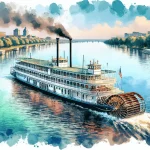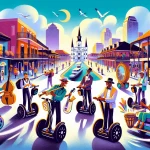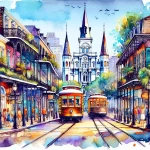New Orleans’ iconic streetcars represent the city’s rich legacy and lively spirit. These vintage trolleys have transported locals and visitors through picturesque neighborhoods and historic districts for over a century, offering an immersive experience that showcases the city’s distinct charm.
In This Article
TL;DR
- New Orleans features five distinct streetcar lines, each offering a unique perspective of diverse neighborhoods and attractions.
- The accessible, affordable, and convenient streetcar system is an ideal way to explore the city and its cultural hubs.
- These emblematic trolleys connect major landmarks, providing travelers an authentic New Orleans experience while being part of the city’s storied history and cultural fabric.
Historical Context of New Orleans Streetcars
The history of New Orleans’ streetcars dates back to the 1830s when the city introduced its first horse-drawn rail cars. Over the years, the system evolved, transitioning to electric streetcars in the late 19th century. A pivotal moment in the history of New Orleans’ streetcars was the desegregation of the system in 1867, a significant event in the city’s civil rights movement.
Navigating New Orleans by Streetcar
Using the streetcar system in New Orleans is a straightforward and enjoyable experience. Riders can purchase tickets through the RTA’s mobile app or at designated kiosks, with options ranging from single-ride passes to multi-day passes for frequent travelers. While the trolleys generally run every 10-15 minutes, it’s advisable to plan ahead and allow for potential delays, especially during peak hours or major events.
The streetcars in New Orleans are fully accessible, with low-floor boarding and designated spaces for wheelchairs and mobility devices, ensuring a comfortable and inclusive experience for all travelers.
Major Streetcar Lines and Their Routes
St. Charles Avenue Line
This iconic green streetcar line runs along the picturesque St. Charles Avenue, passing through the Garden District and Uptown neighborhoods. Riders can admire the grand antebellum mansions, lush oak trees, and the campuses of Tulane and Loyola Universities.
Canal Street Line
The red Canal Street trolleys traverse the heart of downtown, connecting the French Quarter to the City Park and the New Orleans Museum of Art. Along the way, passengers can explore the historic cemeteries and the lush greenery of City Park.
Riverfront Line
The Riverfront Line offers a scenic journey along the Mississippi River, providing access to the French Quarter, the Outlet Collection at Riverwalk, and the Convention Center.
Rampart-St. Claude Line
This line takes riders through the vibrant Marigny and Bywater neighborhoods, known for their street art, music venues, and eclectic eateries. Highlights include the St. Louis Cemetery No. 1 and Louis Armstrong Park.
Loyola-UPT Line
Connecting the Union Passenger Terminal to the Central Business District, this line offers a convenient option for travelers arriving by train or bus, providing easy access to hotels, restaurants, and attractions.
Streetcars and New Orleans Culture
Streetcars have become an integral part of New Orleans’ cultural fabric, inspiring literature, films, and local traditions. Tennessee Williams’ iconic play “A Streetcar Named Desire” immortalized the streetcar as a symbol of the city’s unique character and the complexities of human nature.
During festivals and celebrations, such as Mardi Gras, the streetcars take on a festive atmosphere, adorned with colorful decorations and carrying revelers to and from the festivities. These iconic trolleys have become a beloved part of the city’s cultural tourism experience, offering visitors a glimpse into the authentic spirit of New Orleans.
Seasonal Considerations and Streetcar Travel
While the streetcars operate year-round, certain seasons and events can impact the travel experience. During major festivals like Mardi Gras, the streetcars may experience higher ridership and potential delays, so it’s advisable to plan ahead and allow extra time for your journey.
In the summer months, the streetcars provide a refreshing respite from the heat, offering a breezy ride through the city’s shaded streets. However, during extreme weather conditions, such as hurricanes or severe thunderstorms, the streetcar service may be temporarily suspended for safety reasons.
Enhancing Your Streetcar Experience
To make the most of your streetcar adventure, consider exploring some of the city’s most scenic routes and photo opportunities. The St. Charles Avenue Line offers breathtaking views of the oak-lined streets and historic mansions, while the Riverfront Line provides stunning vistas of the Mississippi River.
Along the way, you can hop off and explore the city’s vibrant culinary scene, from classic Creole restaurants to trendy cafes and bars. Many local establishments are easily accessible from the streetcar lines, offering a unique opportunity to immerse yourself in the city’s flavors and culture.
For those with limited time, consider a streetcar-based itinerary that combines multiple lines and highlights the city’s must-see attractions. Alternatively, for longer stays, you can create your own customized streetcar adventure, exploring different neighborhoods and discovering hidden gems at your own pace.
Future of Streetcars in New Orleans
As New Orleans continues to evolve, the city’s streetcar system is also undergoing changes and improvements. Plans are underway to expand the existing lines and introduce new routes, further enhancing the accessibility and connectivity of the system.
Additionally, the city is exploring ways to integrate modern advancements in public transportation, such as electric or autonomous vehicles, while preserving the charm and historical significance of the traditional streetcars. This balance between innovation and preservation will ensure that the streetcars remain a beloved and sustainable part of New Orleans’ transportation landscape for generations to come.






